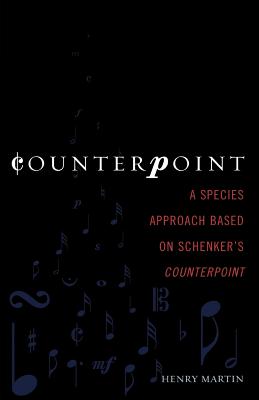Counterpoint is a textbook for use as a stand-alone text in a course on species counterpoint or as a supplementary text for standard college-level courses in music theory. It is based on Heinrich Schenker's (1868-1935) two-volume study of counterpoint. It is intended to help all students of theory or composition to improve their musicianship by examining the voice-leading that underlies Western tonal music. The book proceeds by developing species counterpoint in the tradition of Johann Joseph Fux and his famous Gradus ad Parnassum (1725), but with attention to Schenker's more in-depth study. For the sake of brevity, musical examples are available on the Scarecrow Press website (www.scarecrowpress.com), rather than within the text itself. Everyone from beginning music theory students to composers to graduate composition students will greatly benefit from the methods presented here. Rather than actually teaching a student to compose, working through these exercises will improve musicianship as it applies to both composition and understanding music theory.
Counterpoint is a textbook for use as a stand-alone text in a course on species counterpoint or as a supplementary text for standard college-level courses in music theory. It is based on Heinrich Schenker''s (1868-1935) two-volume study of counterpoint. It is intended to help all students of theory or composition to improve their musicianship by examining the voice-leading that underlies Western tonal music. The book proceeds by developing species counterpoint in the tradition of Johann Joseph Fux and his famous Gradus ad Parnassum (1725), but with attention to Schenker''s more in-depth study. For the sake of brevity, musical examples are available on the Scarecrow Press website (www.scarecrowpress.com), rather than within the text itself. Everyone from beginning music theory students to composers to graduate composition students will greatly benefit from the methods presented here. Rather than actually teaching a student to compose, working through these exercises will improve musicianship as it applies to both composition and understanding music theory.
Get Counterpoint by at the best price and quality guranteed only at Werezi Africa largest book ecommerce store. The book was published by Scarecrow Press and it has pages. Enjoy Shopping Best Offers & Deals on books Online from Werezi - Receive at your doorstep - Fast Delivery - Secure mode of Payment
 Jacket, Women
Jacket, Women
 Woolend Jacket
Woolend Jacket
 Western denim
Western denim
 Mini Dresss
Mini Dresss
 Jacket, Women
Jacket, Women
 Woolend Jacket
Woolend Jacket
 Western denim
Western denim
 Mini Dresss
Mini Dresss
 Jacket, Women
Jacket, Women
 Woolend Jacket
Woolend Jacket
 Western denim
Western denim
 Mini Dresss
Mini Dresss
 Jacket, Women
Jacket, Women
 Woolend Jacket
Woolend Jacket
 Western denim
Western denim
 Mini Dresss
Mini Dresss
 Jacket, Women
Jacket, Women
 Woolend Jacket
Woolend Jacket
 Western denim
Western denim
 Mini Dresss
Mini Dresss






























































